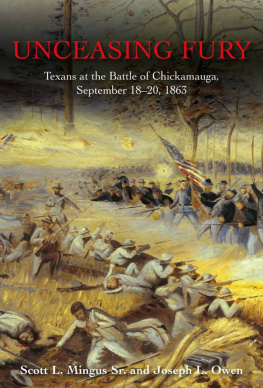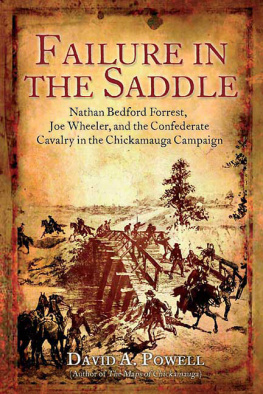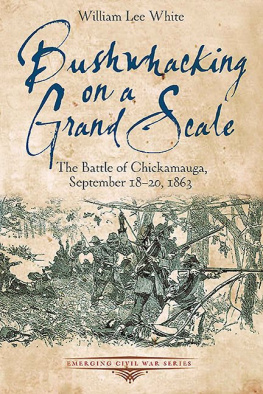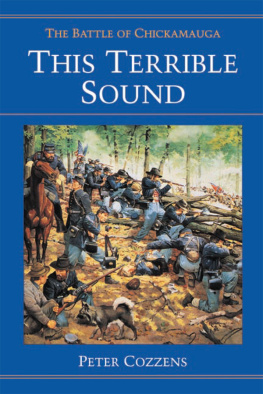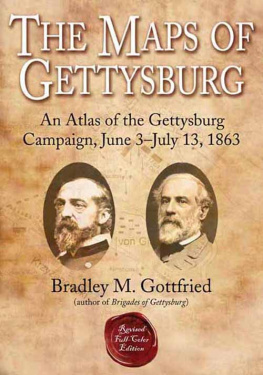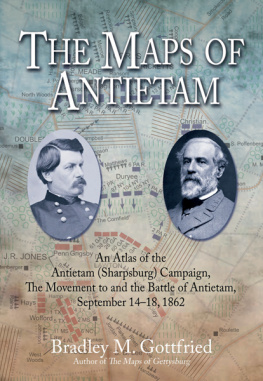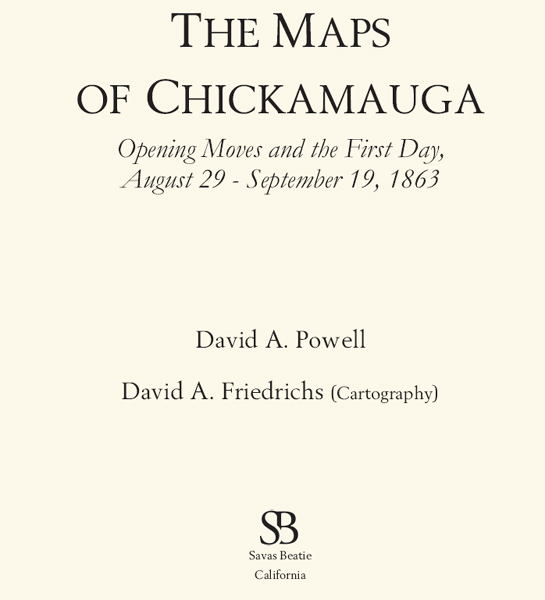
2009 by David Powell (text) and David Friedrichs (cartography)
The Maps of Chickamauga: Opening Moves and the First Day, August 29 - September 19, 1863
All rights reserved. No part of this work may be reproduced, stored in a retrieval system, or transmitted, in any form or by any means, electronic, mechanical, photocopying, recording, or otherwise, without the prior written permission of the publisher.
Cataloging-in-Publication Data is available from the Library of Congress.
ISBN-13: 978-1-932714-72-2
eBook ISBN: 978-1-61121-172-6
10 9 8 7 6 5 4 3 2
First Edition, First Printing

Published by
Savas Beatie LLC
521 Fifth Avenue, Suite 1700
New York, NY 10175
Editorial Offices:
Savas Beatie LLC
P.O. Box 4527
El Dorado Hills, CA 95762
Phone: 916-941-6896
(E-mail)
Savas Beatie titles are available at special discounts for bulk purchases in the United States by corporations, institutions, and other organizations. For more details, please contact Special Sales, P.O. Box 4527, El Dorado Hills, CA 95762. You may also e-mail us at for additional information.
This book is lovingly dedicated to our wives,
Anne Powell and Laura Friedrichs
Contents
The Chickamauga Campaign: Opening Moves
(August 29 - September 18, 1863)
The Battle of Chickamauga
(September 19 - 20, 1863)
Introduction
By any definition this book you now hold in your hands is a labor of love. The general idea germinated in 1997, when I first began researching the battle of Chickamauga for an entirely different project.
Back then I was designing historical war games (paper games, not computer simulations) and wanted to tackle Chickamauga as my next subject. For those of you who aren't familiar with the rather arcane hobby of historical board games, they are highly detailed (some say overly complicated) manual simulations of past events. Printed maps represent the terrain, overlaid with a hexagonal grid that acts as a sort of chessboard, with die-cut cardboard counters portraying the regiments, battalions, batteries, and leaders who fought these epic encounters. Players use these tools to recreate the struggles of the event portrayed or to explore alternative outcomes. Think of them as a step between reading about the event and participating in a Civil War reenactment of it. My goal was to produce an epic of the genre, including as much detail as I could about Chickamauga. Accurate maps of the battlefieldand lots of themwere of prime importance, as were accurate numbers and losses for the organizations that fought there. The project took about a year to complete, and when the game was finally published it was well received. As I soon discovered, I was not yet finished with Chickamauga.
Like so many other people with a strong interest in the Civil War, I spent many years studying Gettysburg (for which I had also designed a board game). The July 1863 battle was the largest of the war. Much of it was fought across generally open terrain, and neither side was broken or driven from the field. Chickamauga was a very different affair. The combat in North Georgia in September 1863 was the Confederacy's only clear-cut victory in the Western Theater (and a barren one at that, rendered so by the crippling Rebel defeat just two months later at Chattanooga). The dark forests and limited clearings triggered a host of unexpected combats, flanking maneuvers, and direct assaults that left commanders on both sides confused as to the exact ebb and flow of the battle. Commanders William Rosecrans (Army of the Cumberland) and Braxton Bragg (Army of Tennessee) exerted only limited control over the action, groping for whatever meager details of the fighting that came their way. Unlike so many battles, Chickamauga was largely fought by brigade, regimental, and sometimes even company commanders; senior officers often remained frustrated spectators to the chaos swirling around them. Thirty years later when the National Park was created, veterans of the battle recognized this truth when they decreed Chickamauga to have been the quintessential soldiers battle. No statues honoring individual generals are to be found on the field.
There were other significant differences. One consideration that drew me to Gettysburg was the wealth of published and easily accessible primary and secondary resources on the battle. I could learn about it in as much detail as I wished. There was always another letter or diary or newspaper account coming to light, or another book being published. I remember at one point many years ago counting nearly ninety Gettysburg-related titles on my personal library shelf. Hundreds more were in print and/or easily available. Gettysburg isand will likely continue to bea publishing mainstay.
The opposite is true about Chickamauga. Nearly all of the primary sources penned on the battle are in archival holdings and old newspapers, and so are not readily available. The secondary literature is remarkably sparse. Despite the battle's size and importance to the course of the Civil War, only two modern battle studies exist: Glenn Tucker's Chickamauga dating from the centennial era, and Peter Cozzens This Terrible Sound, published in 1992. In the microtactical genre (such as the multiple monographs that exist for each of Gettysburg's three days) Archibald Gracie published in 1911 The Truth About Chickamauga, a detailed study of the September 20 afternoon fighting on Horseshoe Ridge. Unfortunately, Gracie's narrative is jumbled, poorly organized, and deeply confusing, and his analysis remains questionable at best. The redeeming aspect of Gracie's work is that he used extensive quotations from actual participants.
At the campaign level, there are several studies available that place Chickamauga in the larger context of the war, including Steven Woodworth's Six Armies in Tennessee and William G. Robertson's excellent five-part series recently published in Blue & Gray Magazine. As of this writing, Dr. Robertson is finishing a new monograph on the campaign, a much-anticipated work those of us fascinated with Chickamauga have long wished to see.
My own interest in Chickamauga continued unabated even after I finished my game design. I started collecting every primary source I could find, visiting or contacting archives and repositories across the country. I also scanned hundreds of period newspapers looking for letters home and casualty reports from men and regiments that had fought at Chickamauga. Somewhere along the line I developed the idea of assembling a map atlas that would explain the battle at the regimental level, tracking all movements at fifteen minute intervals. I knew my computer graphic talents weren't up to that challenge, so I sought a partner for this ambitious project. David Freidrichs was a fellow wargamer and good friend who had the digital and artistic skills I lacked. When I pitched the project to him he signed on quickly. Although we did not yet have a publisher or even a product, at least we had the concept and the means to execute it.
Originally (and foolishly) I estimated it would take about one year to finish the atlas. It was more than a decade later before I understood enough about the battle to begin sketching out draft maps. The time in between was spent reading primary accounts, walking the battlefield, and trying to integrate often conflicting recollections with the terrain under my feet. It was an often frustrating, but ultimately very rewarding, experience.
Next page



